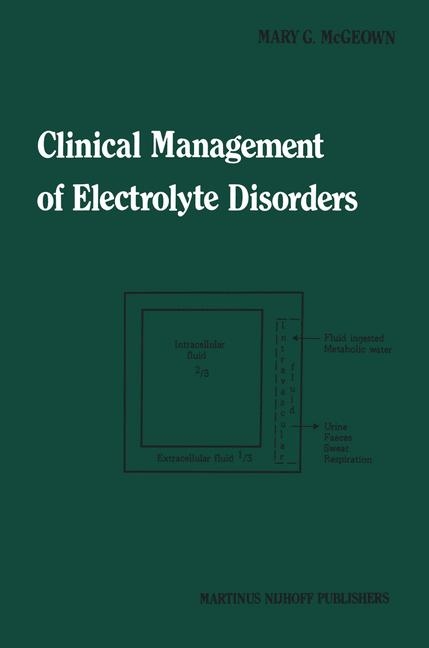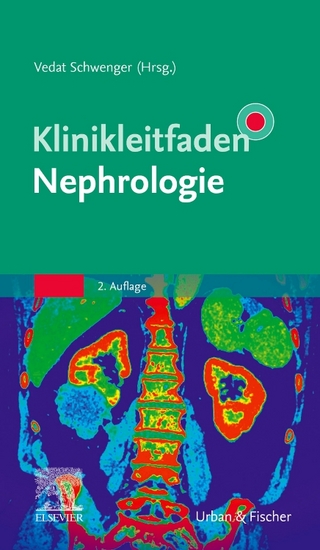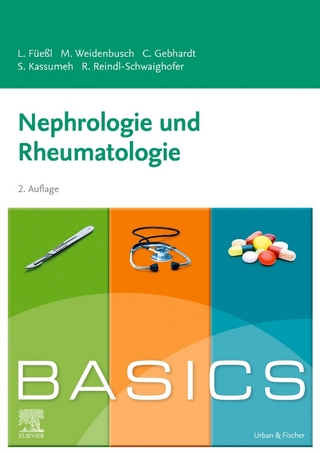
Clinical Management of Electrolyte Disorders
Kluwer Academic Publishers (Verlag)
978-0-89838-559-5 (ISBN)
- Titel ist leider vergriffen;
keine Neuauflage - Artikel merken
1. Basic information relating to body fluids.- 1. Volume.- 2. Solutes.- 3. Mole.- 4. Solution.- 5. Equivalent.- 6. Osmosis.- 7. Osmotic pressure.- 8. Osmolarity, osmolality.- 8.1. Osmolarity.- 8.2. Osmolality.- 9. Isotonicity, hypertonicity, hypotonicity.- 10. Oncotic pressure.- 11. Cell membrane pumps.- 12. Role of enzymes.- 13. Acid/base.- 13.1. Acidosis.- 13.2. Alkalosis.- 13.3. Buffers.- 13.4. Anion gap.- 13.5. Regulation of acid/base.- 13.5.1. Regulation of acid/base by the kidneys.- 13.5.2. Regulation of acid/base by the lungs.- 14. Osmotic dieresis.- 15. Free-water clearance.- 15.1 Effect of volume depletion in chronic renal failure.- 15.2. Polyuria.- 16. Antidiuretic hormone.- 17. Aldosterone.- 17.1. Hyperaldosteronism.- 17.2. Hyporeninaemic hypoaldosteronism.- 2. The fluid compartments of the body.- 1. Fluid compartments.- 2. Composition of plasma and intracellular fluid.- 3. Role of the cell membrane pumps.- 3. What can intravenous therapy accomplish?.- 1. Use of intravenous therapy.- 2. Limitations of intravenous therapy.- 2.1. Limitation of volume.- 2.1.1. Amount of fluid loss.- 2.1.2. Age.- 2.1.3. Cardiac and renal function.- 2.1.4. Time.- 2.1.5. Previous intravenous therapy.- 3. Limitation of osmolality.- 4. Limitation of sodium.- 4.1. Sodium space.- 5. Limitation of hydrogen ion concentration.- 5.1. Respiratory acidosis/alkalosis.- 5.2. Metabolic acidosis.- 5.3. Metabolic alkalosis.- 6. Potassium deficiency.- 4. The clinical history.- 1. Deficient intake.- 2. Vomiting or aspiration.- 3. Loss from gastrointestinal fistulae.- 4. Loss of bile.- 5. Diarrhoea.- 6. Excessive urinary loss.- 7. Impaired renal function.- 8. Urinary diversion operations.- 9. Excessive loss of sweat.- 10. Drug-induced electrolyte disturbances.- 11. Electrolyte disturbances associated with intravenous therapy.- 12. Thirst.- 13. Dyspnoea.- 5. Physical examination of the patient.- 1. Weight.- 2. Temperature.- 3. Skin.- 4. Sweating.- 5. Mucous membranes.- 6. Oedema.- 7. Jugular venous pressure.- 8. Blood pressure.- 9. Hypotension.- 10. Hypertension.- 11. Cardiac assessment.- 12. Lungs.- 13. Anaemia.- 14. Abdomen.- 15. Tendon reflexes.- 16. Restless patient.- 17. Fontanelle in infancy.- 6. Fluid balance records and their interpretation.- 1. Fluid balance chart.- 2. Fluid intake.- 3. Fluid output.- 4. Prescription for intravenous fluids.- 7. Laboratory data and useful investigations.- 1. Chemical substances in body fluids.- 2. Chemical substances in serum/plasma.- 3. Enzymes and hormones in serum/plasma.- 4. Acid/base and gaseous components of blood.- 5. Base excess and buffer base.- 6. Actual and standard bicarbonate.- 7. Plasma total CO2, plasma bicarbonate.- 8. Chemical substances in urine.- 9. Enzymes and hormones in urine.- 10. Renal function tests.- 11. Haematological tests.- 12. Central venous pressure.- 13. Haemodynamic monitoring using the Swan Ganz catheter.- 14. Radiological investigations.- 8. Solutions for intravenous therapy and their uses.- 1. 5% dextrose.- 2. Sodium chloride solutions.- 3. Sodium bicarbonate.- 4. One-sixth molar sodium lactate.- 5. Potassium chloride.- 6. Potassium acetate.- 7. Magnesium sulphate.- 8. Isotonic mixed electrolyte solutions.- 9. Colloidal solutions.- 10. Nutritive solutions.- 11. Ammonium chloride.- 12. Mannitol.- 13. Forced dieresis.- 9. Water loss syndrome.- 1. Pure deprivation of water.- 2. Increased water loss.- 3. Physical signs of water loss.- 4. Laboratory findings of water loss.- 5. Treatment of water loss syndrome.- 6. Amount of water required.- 10. Water excess syndrome.- 1. Water excess caused by intravenous infusion.- 2. Water excess caused by irrigation.- 3. Symptoms and signs of water excess.- 4. Laboratory findings.- 5. Treatment of water excess.- 11. Sodium loss syndrome.- 1. Causes of sodium loss syndrome.- 1.1. Vomiting/aspiration.- 1.1.1. Treatment of electrolyte disturbance due to vomiting/aspiration.- 1.2. Diarrhoeal causes.- 1.2.1. Treatment of diarrhoeal loss.- 1.3. Gastrointestinal and biliary fistulae.- 1.3.1. Treatment of loss via fistulae.- 1.4. Loss through intact skin.- 1.4.1. Treatment of heat exhaustion.- 1.5. Loss through damaged skin.- 1.5.1. Treatment of loss through skin.- 1.6. Sequestration of extracellular fluid.- 1.6.1. Treatment of sequestration of extracellular fluid.- 1.7. Intrinsic renal disease.- 1.7.1. Treatment of renal loss of sodium.- 1.8. Adrenocortical insufficiency.- 1.8.1. Treatment of acute adrenal insufficiency.- 1.9. Diabetic keto-acidosis.- 1.9.1. Treatment of diabetic keto-acidosis.- 1.10. Paracentesis or acupuncture.- 1.11. Drug-induced sodium loss.- 1.12. Bartter’s syndrome.- 12. Hyponatraemia without sodium loss.- 1. Dilutional hyponatraemia.- 1.1. Symptoms and signs of dilutional hyponatraemia.- 1.2. Treatment of dilutional hyponatraemia.- 2. Hyponatraemia with hyperlipidaemia.- 3. Hyponatraemia with hyperproteinaemia.- 4. Hyponatraemia with hyperglycaemia.- 13. Sodium excess syndrome.- 1. Causes of oedema.- 1.1. Cardiac oedema.- 1.1.1. Treatment of cardiac oedema.- 1.2. Hypoproteinaemia.- 1.2.1.1. Treatment of the nephrotic syndrome.- 1.3. Cirrhosis.- 1.4. Hormonal oedema.- 1.5. Idiopathic oedema.- 14. Hypernatraemia.- 1. Water deprivation.- 2. Increased water loss.- 3. Inappropriate administration of sodium.- 4. Haemodialysis against concentrated dialysis fluid.- 5. Hyperaldosteronism.- 6. Essential hypernatraemia.- 7. Treatment of hypernatraemia.- 15. Disturbances of potassium metabolism.- 1. Potassium and neuromuscular transmission.- 2. Potassium disturbances and renal function.- 3. Potassium and acid/base status.- 4. External potassium balance.- 5. Hypokalaemia.- 6. Hyperkalaemia.- 16. Metabolic acidosis.- 1. Metabolic acidosis with normal anion gap.- 2. Metabolic acidosis with increased anion gap.- 3. Symptoms and signs of acidosis.- 4. Treatment of metabolic acidosis.- 17. Metabolic alkalosis.- 1. Causes of metabolic alkalosis.- 2. Symptoms and signs of metabolic alkalosis.- 3. Treatment of metabolic alkalosis.- 18. Respiratory disturbances of acid/base.- 1. Primary respiratory acidosis.- 1.1. Causes of respiratory acidosis.- 1.2. Symptoms and signs of respiratory acidosis.- 1.3. Treatment of respiratory acidosis.- 1.4. Carbon dioxide narcosis.- 2. Primary respiratory alkalosis.- 2.1. Causes of respiratory alkalosis.- 2.2. Symptoms and signs of respiratory alkalosis.- 2.3. Treatment of respiratory alkalosis.- 3. Mixed acid/base disturbances.- 3.1. Respiratory acidosis and compensatory metabolic alkalosis.- 3.2. Metabolic alkalosis and compensatory respiratory acidosis.- 3.3. Respiratory alkalosis and metabolic acidosis.- 3.4. Respiratory acidosis and metabolic acidosis.- 3.5. Respiratory alkalosis and metabolic alkalosis.- 3.6. Metabolic acidosis and metabolic alkalosis.- 19. Calcium and phosphorus.- 1. Parathyroid hormone.- 2. Vitamin D.- 3. Vitamin D and the serum phosphate.- 4. Calcitonin.- 5. Thyroxine.- 6. Adrenals.- 7. Growth hormone.- 8. Insulin.- 9. Calcium absorption.- 10. Urinary excretion of calcium.- 11. Hypercalciuria.- 11.1. Causes of hypercalciuria.- 11.2. Treatment of hypercalciuria.- 12. Reduced urinary excretion of calcium.- 13. Hypocalcaemia.- 13.1. Causes of hypocalcaemia.- 13.2. Symptoms and signs of hypocalcaemia.- 13.3. Treatment of hypocalcaemia.- 14. Hypercalcaemia.- 14.1. Causes of hypercalcaemia.- 14.2. Symptoms and signs of hypercalcaemia.- 14.3. Treatment of hypercalcaemia.- 15. Hypophosphataemia.- 15.1. Causes of severe hypophosphataemia.- 15.2. Symptoms and signs of hypophosphataemia.- 15.3. Treatment of hypophosphataemia.- 20. Magnesium.- 1. Hypomagnesaemia.- 1.1. Causes of hypomagnesaemia.- 1.2. Symptoms and signs of hypomagnesaemia.- 1.3. Treatment of hypomagnesaemia.- 2. Hypermagnesaemia.- 2.1. Symptoms and signs of hypermagnesaemia.- 2.2. Treatment of hypermagnesaemia.- 21. Parenteral nutrition.- 1. Parenteral nutrition.- 2. Planning parenteral nutrition.- 3. Method of administration.- 4. Scheme for parenteral nutrition.- Further reading.- Appendices.
| Erscheint lt. Verlag | 31.3.1983 |
|---|---|
| Reihe/Serie | Developments in Critical Care Medicine and Anaesthesiology ; 2 |
| Zusatzinfo | XVII, 201 p. |
| Verlagsort | Dordrecht |
| Sprache | englisch |
| Gewicht | 510 g |
| Themenwelt | Medizinische Fachgebiete ► Innere Medizin ► Nephrologie |
| Medizin / Pharmazie ► Medizinische Fachgebiete ► Intensivmedizin | |
| ISBN-10 | 0-89838-559-8 / 0898385598 |
| ISBN-13 | 978-0-89838-559-5 / 9780898385595 |
| Zustand | Neuware |
| Haben Sie eine Frage zum Produkt? |
aus dem Bereich


